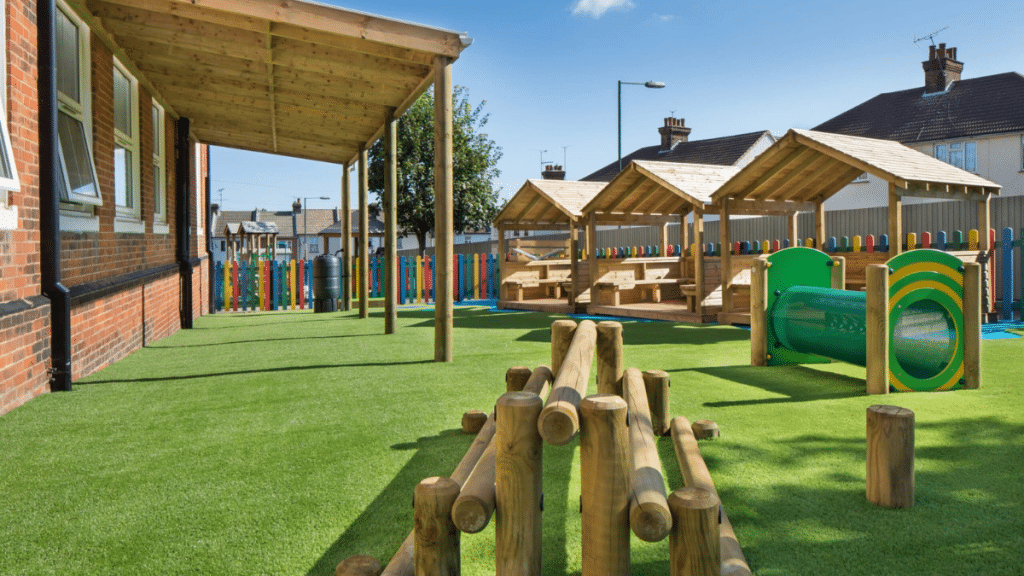If you’re thinking about redesigning your school’s outdoor area, there are a lot of factors to consider. You’ll want to design with intentionality, to make the space meaningful and enriching for your students. Of course you’ll want to make the obvious changes, like repainting chipped surfaces and replacing old equipment. But it’s also important to think about redesigning to boost cognitive development, physical health, social interaction, and creativity.
Before you dive in, however, it’s a good idea to pause and think strategically about how you want your space to take shape. Doing so can help you reign in costs, prevent poor spur of the moment decisions, and ensure positive outcomes. After all, designing for a school isn’t unlike designing for a miniature City. You have to know what the people need and how to give it to them while coming in under budget. Here’s how to make it happen.
Setting Your Goals
The first order of business is to start setting specific goals around the function of your outdoor space. What are your priorities? Do you want to encourage more interaction with nature? Do you need to prevent obesity and improve kids’ physical fitness? Do you want to encourage more structured outdoor time or help kids unleash their creativity? Understanding your goals can help you make better decisions and build a truly functional space.
For example, when you think about playground equipment, don’t just think about entertaining the kids. Instead, consider how the equipment will stimulate them intellectually or challenge them to develop more physical dexterity. Modern playground structures are virtually limitless in their possibilities and there are so many options to choose from. It’s not just slides and monkey bars, but musical instruments, climbing walls, ropes courses and giant puzzles to be solved.
Think Beyond the Jungle Gym
School administrators can get caught up in the process of choosing playground equipment to please their students. However, it’s also important to think about the finer details, like shaded areas for reading, or paths for walking and wandering. It’s also important to consider how the space might be used for educational purposes. Consider outdoor gathering areas, nature-based classrooms, science labs, and reading and art nooks throughout the space.
A well-designed outdoor space should be built to nurture both introversion and group social interaction. Consider benches and picnic tables to accommodate chatty students, and more secluded areas to suit the introverts. Remember the more flexible and varied the space the more use you’ll get out of it over time. Consider also the fact that your kids are going to age so the way individual children use the playground will also evolve with the years.
Design for Inclusivity
Designing for everyone isn’t just about designing for different uses. It’s also about making the spaces as inclusive as possible so that all of your students can always use it. That means designing with wheelchair friendly surfaces and other accessibility features. Don’t forget the details, like easy-grip playground equipment, and sensory-friendly areas for students on the spectrum. When in doubt, consult ADA guidelines or enlist the help of a specialized consultant.
Inclusivity doesn’t just mean designing around disability. It also means avoiding designs that could be offensive or problematic in nature. Don’t choose playground themes that could be considered offensive, like ones that appropriate Native American Heritage or concepts. In certain religious communities, it might also be appropriate to have separate play areas for different genders. Or, it might make more sense to design all structures with modesty and privacy in mind.
Build for Longevity
The most attractive outdoor space designs are useless if everything falls apart within a couple of years. Even high quality structures, however, can require significant maintenance and a considerable investment of time and money. When designing your outdoor space, it’s important to do your due diligence and choose materials that last. Consider how your playground structures, benches, surfacing, and more, can be exposed to wear and tear with foot traffic.
For example, a recent trend is to design outdoor spaces and playground structures with natural materials like wood. What many buyers don’t consider, however, is how much work goes into waterproofing and maintaining those structures. Sure, trees last a very long time in nature, but in schools, they’re also more vulnerable to erosion and chipping. Plastic and metal structures may seem less sustainable, but they tend to have a much longer shelf life in the end.
Invite Outside Input
However you design your playground, it’s important to get feedback and input from your community. Give them a say in the goals and objectives you set, for example letting them submit their ideas or vote on yours. Make sure parents have a chance to tell you what they think would be best for their children (and future generations). Ask teachers about their needs for the space, or potential challenges they might encounter when supervising children there.
It’s also not a half bad idea to ask the children themselves what they think would work best for them. Of course, you’re not going to give them final say over the finished product, but they know a thing or two, and they might surprise you. Children can be incredibly creative about coming up with solutions and brainstorming innovative ideas. Plus, they’re more likely to care for the space if they’re emotionally invested because it feels like their own.
Shaping Your Space
Upgrading your school’s outdoor space is about more than just getting a new playground or doing some landscaping. It’s an opportunity to shape your students’ academic, personal, emotional, and physical growth. By thinking strategically and inviting the right people into your planning process, you set yourself up for success. Don’t rush the process. Instead, maintain focus on a clear vision for how your space will create happier, healthier students.

